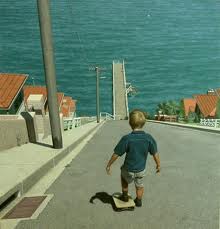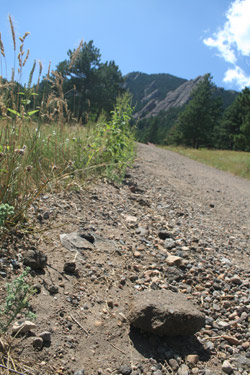Feb
14
2011

I’m not a mystic, but what I am about to tell you is the true story of Jim Hathaway, a crotchety old editor who found a way to give me the exact writing advice I needed, at the critical moment — and even better — several years after he was dead and buried. Given Jim’s strength of will, I doubt even cremation would have stopped him.
Jim was a member of The Lafayette Park Writers, a critique group of retired editors, columnists, English professors, novelists, and one traveling actress. Each week they met in a city parks and rec building and enthusiastically welcomed each newbie who fell in off the street. Each of the core members was experienced and nurturing, and each in his own right could have lit up Sin City on the sheer strength of his personality and charm. But even in that group, Jim stood out.
Tall, svelte, and mostly bald, Jim wore double-knit pants and white shoes. He had a pugnacious delivery, a voice like a cheese grater, and in spite of his liver-spotted skin and huge ears, blue eyes as round and eager as any eight-year-old boy’s. I admired a lot about Jim, but the quality I most respected was his life-long elasticity, his willingness to reinvent his skills, his writing, and himself with each new physical challenge or technical advance placed before him. In writing and in life you could always spot Jim; he was the barefoot, shirtless boy skateboarding fearlessly down Breakneck Hill.
Continue reading
10 comments | tags: actress, address, Breakneck Hill, business, cardinal, cat, char, cheese grater, columnist, comfort, copyright, cremation, crisis, critique, daughter, double-knit, editor, elastic, English professor, essay, family, fiction, film, final draft, funeral, ghost, grief, in-laws, infancy, Lafayette Park, linoleum, liver spots, mailbox, mentor, mother, mystic, novelist, paper, pen, personality, physical challenge, poem, priest, reinvent, revelation, short story, sign of the cross, Sin City, skill, suicide, supernatural, teacher, technical advance, technique, white shoes, will, writing, writing advice | posted in On Writing
Feb
3
2011
 Two a.m. A full moon casts a bright ribbon over the Gulf, sand sinks under my feet as the waves wash away, and everything shimmers in a cool shade of blue. We’re here to see the sea turtles hatch, to learn lessons from these tiny leaps of faith and their struggle to reach the sea.
Two a.m. A full moon casts a bright ribbon over the Gulf, sand sinks under my feet as the waves wash away, and everything shimmers in a cool shade of blue. We’re here to see the sea turtles hatch, to learn lessons from these tiny leaps of faith and their struggle to reach the sea.
There are predators about, ghost crabs that eat baby turtles. Our children are horrified. They chase the mean crabs all over the shore, looking a bit like crabs themselves as they scurry, bent-over and snapping their kitchen tongs. They are amazingly agile and their mission is pure. The crabs don’t stand a chance.
We come to a nest. It’s just a small slump in the sand, but underneath lie hundreds of little miracles biding their time. We look for movement, find none, and stroll on.
Eight nests later we have a plastic pitcher full of crabs, but we haven’t seen a single turtle. The children break for the water. The waves are dreamy; they glide onto shore with the genteel rustle of taffeta skirts. Our children splash right in.
Immediately they stop as one and gawk at the water. Splash again, swing their hands and knees, gawk some more. I scoop up a ball of water and toss it into the air; it falls, bouncing into pieces against my hands. Neon green sparks shoot like fireworks. Bioluminescence, Jim explains. Tiny sea creatures emitting light.
Turning for home, I take Jim’s hand and feel another spark of nature, one that hasn’t faded, not in thirty years. The world is full of miracles. Continue reading
10 comments | tags: beach, bioluminescence, crabs, essay, family, inspirational, leaps of faith, light, love, miracle, next, sand, sea creatures, sea turtles, spark of nature, waves | posted in On Life
Jan
28
2011

Before a storm there’s an energy in the air, a rushing through leaves and branches, an inevitability that hasn’t yet reached down and touched you here on the ground. Life’s big changes often start like this, but sometimes the seismic shifts in our lives begin with a trickle, a few grains of sand, a small pebble that rolls barely noticed downhill. Life’s busy; you’re hardly aware of the whisper of draining sand, but it continues, slowly, steadily, at the pace of erosion, until suddenly your mountain slides into rubble. I imagine many a dream, a career, and marriage have slid down that mountain, victim to our disregard. Status quo is so much simpler than change. Until you look up and see the boulders falling onto you.
When Jim and I were first married I remember thinking we were too happy, that it couldn’t last. But it did. We weren’t wealthy, but we were blessed with two apt and engaged boys, two bright and inventive girls, and with some major penny pinching, I was able to stay home with them full time. I shopped consignment stores, and refinished furniture, and took our good fortune for granted. Then a pebble bounced from overhead and landed at my feet. We lost our income. Times were tight and jobs were scarce so after a few months of looking for work, we decided to start a business. We faced a lean and nervous year, but strangely, what I felt was a sense of relief. Hardship had finally arrived, but the money problems we faced were the best kind of problem to have.
Then a rock fell. My father was diagnosed with both Alzheimer’s and Parkinson’s diseases, along with the myriad of health problems he already had. I became responsible for his care and finances, as well as his rental properties in another state. Life became physically demanding, but it was the emotional and moral stress that made it harder and harder to crawl out of bed and face the day. What kind of daughter would take her father to court and have him committed? What kind of daughter would obey her father’s wishes and leave him where he was, ill and alone? A bear-sized man who often fell down and couldn’t get up and now wandered, lost and afraid, in his own home? I was the one person he trusted to make the right choice. I did, but it wasn’t easy.
And then the big boulders began to hit.
Continue reading
4 comments | tags: Alzheimer's disease, change, consignment store, DNR, essay, family, father, friends, heart, illness, inspirational, job loss, kidney, landslide, mountain, parent, Parkinson's disease, seismic shift, support, surviving difficulty | posted in On Life
Jan
18
2011

Mottled leaves drift and spin, brightly flickering through clear, brisk air as gravity and wind play their autumn game. Our children run and shriek, caught in the wind-blown excitement of the first Canadian front. Its currents whisper sweet promises of candy apples and ghostly costumes, holiday feasts and velvet dresses, cold cheeks, muffs, and cinnamon mingling with buttered brown sugar. And something more, I think, allowing a stillness to settle into my mood. On days such as this, children reveal truths so quiet and subtle they often go unnoticed. I resolve this afternoon, to listen.
Our youngest daughter, Lauren, searches through piles of leaves for hidden treasures. She brings her finds inside and lays them across the oak table in our kitchen. We peruse them one by one: a maple’s brilliant red star, a burning-orange crepe myrtle leaf, brown sycamore hands, a tallow’s purple heart and one simple green leaf now prized for so persistently holding onto its summer color. We delight in their variety: flocked and papery thin, brown-crackle thick, waxy, serrated, smooth, perfect oval. It is impossible to choose a favorite.
Looking up from the table, we spy visitors through the bay window, a quail couple we’ve observed since early spring. This time they’ve brought their brood. Heads bob and tails wiggle as they promenade through the yard. “Oh, cute! Look how many!” We rush to count – nine, eleven, twelve . . . twelve babies! “Oh, no!” One is going off on its own. Our hands flatten against the window panes and we hold our breath, but the mother quail is no slacker. With the crispness of a drill sergeant, she runs after her errant child and nudges it back in line. Our lungs fill with air.
Continue reading
47 comments | tags: ant, Asian, autumn, beauty, bird, black, blue jays, bottom fishing, brown sugar, brown thrasher, bugs, canadian front, candy apples, cardinals, caterpillar, children, cinnamon, collection, confectioner's sugar, costumes, crayons, crepe myrtle, crow, cultures, diversity, eaden, earth, entoologists, essay, fall, family, feasts, fiddler crab, fisherman, fishing, french toast, fruit fritters, game, grass, heterogeneous, holiday, inspirational, leaves, live-line, mackerel, magnifying glass, maple, markers, martian, mocking bird, moth, nature, net, people, plant, quail, race, roly-polie, safari, shark, sheepshead, snowflake, sparrow, sycamore, tallow tree, tanager, tolerance, truth, twigs, velvet dresses, wind | posted in On Life



